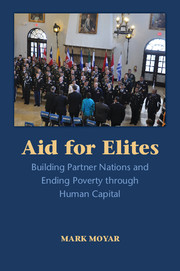Book contents
- Frontmatter
- Contents
- Preface
- Acknowledgments
- 1 Pathways to Development
- 2 How Governments Work
- 3 Civilization
- 4 Human Capital Development
- 5 Human Capital and National Security
- 6 Training
- 7 Militarization
- 8 Education in the Third World
- 9 Education in the United States
- 10 Support
- 11 Measurement
- 12 Conclusion: A New Foreign Assistance Strategy
- Notes
- Index
- Frontmatter
- Contents
- Preface
- Acknowledgments
- 1 Pathways to Development
- 2 How Governments Work
- 3 Civilization
- 4 Human Capital Development
- 5 Human Capital and National Security
- 6 Training
- 7 Militarization
- 8 Education in the Third World
- 9 Education in the United States
- 10 Support
- 11 Measurement
- 12 Conclusion: A New Foreign Assistance Strategy
- Notes
- Index
Summary
The issue of measurement hangs over all U.S. foreign assistance programs of the present era. Many aid officials and many of their overseers in the executive and legislative branches deem quantitative measurement essential to the assessment of effectiveness, the management of aid programs, and the allocation of aid dollars. Quantitative data can indeed contribute much in all these respects. The concern over measurement of results has, moreover, been helpful in correcting past tendencies to assume that programs were effective simply because they conformed to preconceived notions about aid, such as the notion that giving money to the poor necessarily improves their lives, or the notion that handing out pamphlets on female empowerment is certain to promote gender equality. But measurement, especially that of a quantitative nature, has received so much emphasis, and has been advanced in so dogmatic a manner, that it now undermines the very activities it is supposed to be helping.
THE RISE OF MEASUREMENT
Much of the American public is skeptical about foreign aid because of past instances of corruption, the persistence of third world dysfunction after decades of aid, and the perception that foreign aid accounts for a huge chunk of spending by first world governments. The first two concerns are thoroughly justified, as the preceding chapters attest. The third is not: The average American believes that foreign aid constitutes 10 percent of the federal budget, when in reality it accounts for approximately 1 percent. Even if this misperception were corrected, however, the public would still have ample reason for skepticism. Because of foreign aid's shoddy track record, voters and their elected representatives now feel compelled to demand that aid organizations show measurable results and show them quickly if they wish to survive, much as investors would demand of the management of a company that has been underperforming for years.
U.S. governmental agencies also receive demands for measurements from an ever-expanding group of oversight and regulatory agencies, which includes the Office of Management and Budget, the Government Accountability Office, various inspectors-general, and a multitude of congressional committees. The accountants, economists, procurement officers, and legislative staffers who run these organizations bear the stamp of professors in public administration, business administration, or economics who overemphasized quantification in educating them. These agencies are themselves subjected to pressure for numbers from Congress and the White House.
- Type
- Chapter
- Information
- Aid for ElitesBuilding Partner Nations and Ending Poverty through Human Capital, pp. 185 - 194Publisher: Cambridge University PressPrint publication year: 2016

